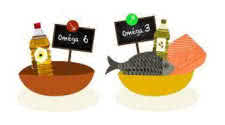Omega-3 vs Omega-6 Fish Oil - Polyunsaturated Fatty Acids

Not All Fats Are Created Equal
Although these two fats might sound like different generations of the same video game, it's important to understand the distinction between them to get the most from your bodybuilding diet.
To cut back on omega-6 fatty acids, go easy on cooking oil and fried foods, both of which are rich in omega-6s. The trendiest way to get more omega-3s is to take flaxseed oil, which is rich
in the omega-3 fatty acid alpha-linolenic acid. Unfortunately, research in humans suggests you need about 30 grams (g) of it to receive full benefit. Alpha-linolenic acid is also not as good
against aches and inflammation as is eicosapentaenoic acid (EPA) from salmon oil, for example, although it tastes better and is easier to use in quantity.
To get the most beneficial omega-3s from food alone, eat oily cold-water fish, such as salmon, mackerel, trout, herring, bass or tuna, three times per week. About 10-30% of fat calories from
these fish will be omega-3 fatty acids (salmon oil being the richest at 30%). Strangely, commercially available "fish oil concentrate" pills are usually only 30% omega-3 fatty acids, offering
no advantage over salmon oil. When you eat canned tuna, make sure it's packed in water, not vegetable oil, which is rich in omega-6 fatty acid. Unfortunately, fish such as cod, halibut,
snapper and sole are duds where omega-3s are concerned.
If you don't like eating fish, your second option is to take 6 g of fish oil per day in capsule form, giving you the same amount of omega-3 fatty acids used successfully in clinical trials
for arthritis and other aches and pains. Unfortunately, downing six 1 g capsules per day may not be easy or convenient, as they're like horse pills (kinda big). You can instead take a
tablespoon of bottled salmon oil or fish oil concentrate, but you may find this to be like cod liver oil, warranting a big Mr. Yucko sticker. Steer away from products containing the word "liver"
(e.g., cod or halibut liver oil), because they're higher in vitamins A and D than they are in omega-3 fatty acids.
Omega-3 fatty acids are passed down a long food chain starting with algae. As a result, the cheapest source of omega-3s is algae-source docosahexaenoic acid (DHA). Cold-water fish ultimately
get their DHA from algae and use it to make EPA as a kind of blood-thinning antifreeze. Seal oil is also rich in omega-3 fatty acids (because they eat the fish), and you can buy seal oil from
specialty vendors in Newfoundland, Canada. However, the cheapest (and most politically correct) source of omega-3s is algae. Normally, each capsule has 100-200 milligrams (mg) of DHA; 200 mg
gives you the omega-3 equivalent of a 1,000 mg (1 g) salmon or fish oil extract capsule at a size that's easier to swallow.